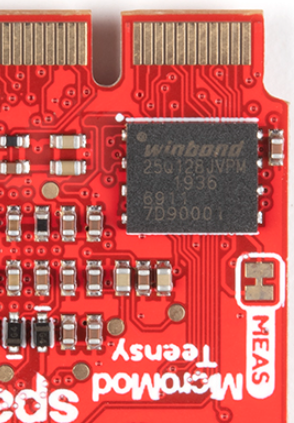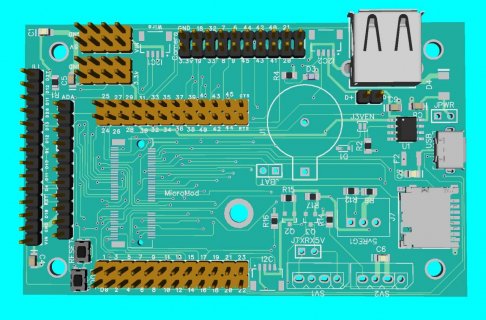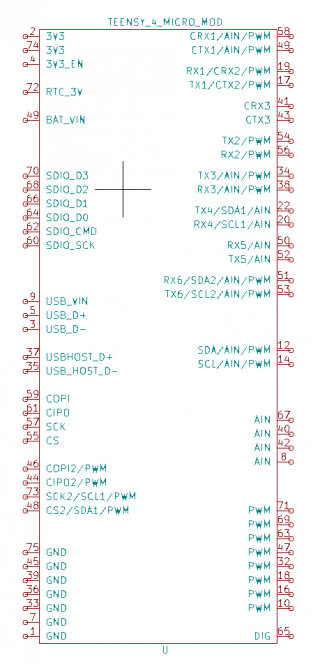Pin MM Pin Name GPIO Serial I2C SPI PWM CAN Audio XBAR FlexIO Analog SD/CSI/LCD
0 17 AD_B0_03 1.3 Serial1(6) RX SPI1(3) CS0 PWM1_X1 2_RX IO-17
1 19 AD_B0_02 1.2 Serial1(6) TX SPI1(3) MISO PWM1_X0 2_TX IO-16
2 47 EMC_04 4.4 PWM4_A2 2:TX_DATA IO-06 1:4
3 32 EMC_05 4.5 PWM4_B2 2:TX_SYNC IO-07 1:5
4 10 EMC_06 4.6 PWM2_A0 2:TX_BCLK IO-08 1:6
5 18 EMC_08 4.8 PWM2_A1 2:RX_DATA IO-17 1:8
6 71 B0_10 2.10 PWM2_A2, QT4_1 1:TX3_RX1 2:10 LCD_DATA6
7 56 B1_01 2.17 Serial2(4) RX PWM1_B3 1:TX_DATA IO-15 2:17, 3:17
8 54 B1_00 2.16 Serial2(4) TX PWM1_A3 1:RX_DATA IO-14 2:16, 3:16
9 69 B0_11 2.11 PWM2_B2,QT4_2 1:TX2_RX2 2:11 LCD_DATA7
10 55 B0_00 2.0 SPI(4) CS0 QT1_0 MQS_RIGHT 2:0 LCD_CLK
11 59 B0_02 2.2 SPI(4) MOSI QT1_2 1_TX 2:2 LCD_HSYNC
12 61 B0_01 2.1 SPI(4) MISO QT1_1 MQS_LEFT 2:1 LCD_ENABLE
13 57 B0_03 2.3 SPI(4) SCK QT2_0 1_RX 2:3 LCD_VSYNC
14/A0 34 AD_B1_02 1.18 Serial3(2) TX QT3_2 SPDIF_OUT 3:2 A1:7, A2:7
15/A1 38 AD_B1_03 1.19 Serial3(2) RX QT3_3 SPDIF_IN 3:3 A1:8, A2:8
16/A2 20 AD_B1_07 1.23 Serial4(3) RX Wire1(3) SCL SPDIF_EXTCLK 3:7 A1:12, A2:12 USDHC2_DATA3
17/A3 22 AD_B1_06 1.22 Serial4(3) TX Wire1(3) SDA SPDIF_LOCK 3:6 A1:11, A2:11 USDHC2_DATA2
18/A4 12 AD_B1_01 1.17 Serial3(2) RTS Wire(1) SDA QT3_1 3:1 A1:6, A2:6
19/A5 14 AD_B1_00 1.16 Serial3(2) CTS Wire(1) SCL QT3_0 3:0 A1:5, A2:5
20/A6 52 AD_B1_10 1.26 Serial5(8) TX 1:RX_SYNC 3:10 A1:15, A2:15
21/A7 50 AD_B1_11 1.27 Serial5(8) RX 1:RX_BCLK 3:11 A1:0, A2:0
22/A8 49 AD_B1_08 1.24 PWM4_A0 1_TX 3:8 A1:13, A2:13 USDHC2_CMD
23/A9 58 AD_B1_09 1.25 PWM4_A1 1_RX 1:MCLK 3:9 A1:14, A2:14 USDHC2_CLK
--- ---- ---- ------ --- --- --- --- ---- ---- ----- ------
24/A10 53 AD_B0_12 1.12 Serial6(1) TX Wire2(4) SCL PWM1_X2 A1:1
25/A11 51 AD_B0_13 1.13 Serial6(1) RX Wire2(4) SDA PWM1_X3 GPT1_CLK A1:2
26/A12 67 AD_B1_14 1.30 SPI1(3) MOSI 1:TX_BCLK 3:14 A2:3
27/A13 8 AD_B1_15 1.31 SPI1(3) SCK 1:TX_SYNC 3:15 A2:4
28 4 EMC_32 3.18 Serial7(7) RX PWM3_B1
29 16 EMC_31 4.31 Serial7(7) TX SPI2(1) CS1 PWM3_A1
30 41 EMC_37 3.23 GPT1_3 3_RX 3:MCLK IO-23
31 43 EMC_36 3.22 GPT1_2 3_TX 3:TX_DATA IO-22
32 65 B0_12 2.12 1:TX1_RX3 IO-10 2:12 LCD_DATA8
33 63 EMC_07 4.7 PWM2_B0 2:MCLK IO-09 1:7
SD Pins - Cable connector(T4 34-39)
34 66 SD_B0_03 3.15 Serial5(8) RTS SPI2(1) MISO PWM1_B1 IO-07 DATA1
35 64 SD_B0_02 3.14 Serial5(8) CTS SPI2(1) MOSI PWM1_A1 IO-06 DATA0
36 60 SD_B0_01 3.13 Wire1(3) SDA SPI2(1) CS0 PWM1_B0 IO-05 CLK
37 62 SD_B0_00 3.12 Wire1(3) SCL SPI2(1) SCK PWM1_A0 IO-04 CMD
38 68 SD_B0_05 3.17 Serial5(8) RX FLEXSPI B_DQS PWM1_B2 IO-09 DATA3
39 70 SD_B0_04 3.16 Serial5(8) TX FLEXSPI B_SSO_B PWM1_A2 IO-08 DATA2
Micromod new pins
40 40 B0_04 2:04 Wire3(2) SCL QT2_1 2:4 LCD_DATA0
41 42 B0_05 2:05 Wire3(2) SDA QT2_2 2:5 LCD_DATA1
42 44 B0_06 2:06 QT3_0 2:6 LCD_DATA2
43 46 B0_07 2:07 QT3_1 2:7 LCD_DATA3
44 48 B0_08 2:08 QT3_2 2:8 LCD_DATA4
45 73 B0_09 2:09 QT4_0 2:9 LCD_DATA5
USB Pins
HUSB D+ 35
HUSB D- 37
USB D+ 3
USB D- 5





